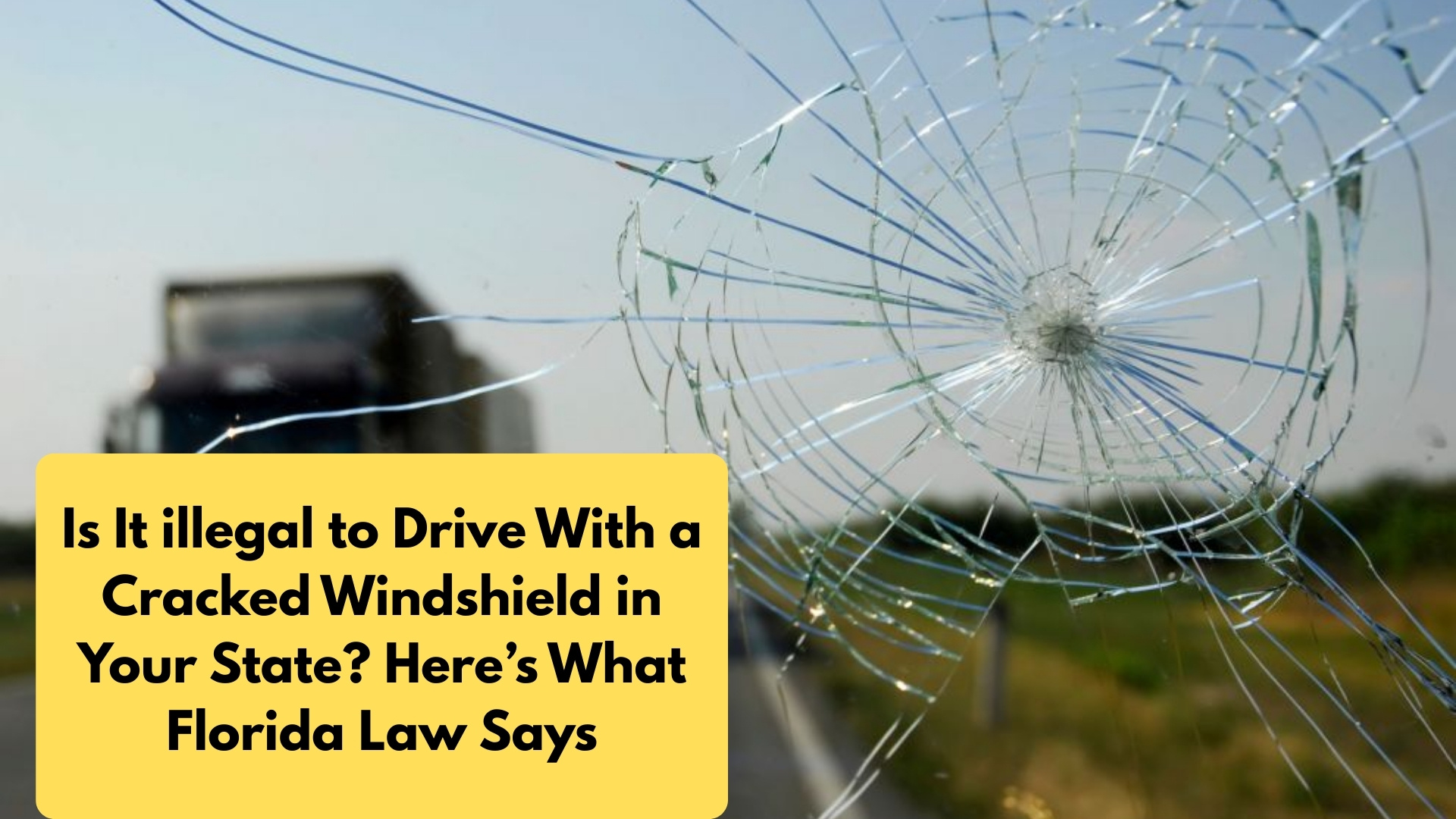A crack across your windshield is more than just an unsightly distraction; it’s a potential safety hazard and a possible magnet for a traffic citation. While a tiny rock chip might seem harmless, that chip can spiderweb into a major crack with a sudden temperature change or a minor bump, drastically compromising your vehicle’s safety and your visibility.
The laws governing windshield damage vary significantly from state to state, creating a confusing patchwork of regulations for drivers. What’s a minor nuisance in one state could be a ticketable offense—or worse, grounds for an unsafe vehicle stop—in another.
This long-form article dives into the critical question: Is it illegal to drive with a cracked windshield in your state? We’ll provide a broader view of common state and federal guidelines, then focus on a comprehensive, in-depth analysis of the unique and often misunderstood cracked windshield laws in the Sunshine State.
The National Landscape: Why Windshield Laws Exist
At its core, a cracked windshield law is a safety regulation. The windshield is an essential component of a vehicle’s safety system, providing three crucial functions:
- Driver Visibility: The most obvious role is to provide a clear, unobstructed view of the road. Any damage—chips, cracks, or large obstructions—that falls within the driver’s critical viewing area can impair perception and reaction time.
- Structural Integrity: In modern vehicles, the windshield provides up to 40% of the roof’s structural support in a rollover accident. A weakened or cracked windshield can shatter or pop out, allowing the roof to crush inward more easily, severely increasing the risk of serious injury.
- Airbag Deployment: The passenger-side airbag relies on the structural integrity of the windshield to properly deploy and cushion the occupant. If the glass is compromised, the airbag may not deploy correctly, leading to devastating consequences.
Federal Guidelines: Setting the Baseline
While enforcement is left to the states, the U.S. Department of Transportation (DOT) sets minimum standards for the glazing material and visibility zones. The general federal rule of thumb often cited by auto glass professionals is:
- Damage is allowed if it is less than $\frac{3}{4}$ of an inch in diameter.
- The damage must not be within 3 inches of another crack or chip.
- Crucially, no damage is allowed in the critical viewing area directly in front of the driver (the area swept by the wipers, from the top of the steering wheel to the top edge of the windshield).
State-by-State Variation
Most states fall into one of three regulatory categories regarding windshield damage:
- Strict States (e.g., New Hampshire, Idaho): These states often have specific, very low thresholds for any crack or chip, sometimes deeming almost any damage illegal.
- Size and Location States (e.g., California, Louisiana): These laws define the maximum size of a crack or chip (e.g., no crack longer than 1.5 inches, no starburst larger than 3 inches) and strictly prohibit any damage within the driver’s immediate line of sight.
- “Unsafe Condition” States (e.g., Florida, Arizona): These states rely heavily on a general statute that prohibits driving a vehicle in an “unsafe condition” or one that “endangers any person or property.” This often gives law enforcement officers considerable discretion in determining whether the damage constitutes a traffic violation.
Florida’s Unique Approach: The Windshield Law Explained
Florida, the Sunshine State, has one of the most interesting and debated cracked windshield laws in the country. Instead of a simple statute that says “Cracks over X inches are illegal,” Florida law is governed by a combination of traffic statutes and an influential Supreme Court ruling.
The Governing Statute: Florida Statute $\S316.610(1)$
The primary legal text is Florida Statute $\S316.610(1), which addresses the safety of a vehicle and its inspection. It states:
“It is a violation of this chapter for any person to drive or move … on any highway any vehicle … which is in such unsafe condition as to endanger any person or property, or which does not contain those parts or is not at a1ll times equipped with such lamps and other equipment in proper condition and adjustment…”2
A cr3acked windshield is not explicitly listed as a violation under other equipment statutes ($\S316.2952$). Therefore, an officer who issues a ticket for a cracked windshield is essentially asserting that the damage renders the vehicle in an “unsafe condition” that endangers people or property.
The Landmark Precedent: Hilton v. State (2007)
The interpretation of this “unsafe condition” clause was clarified by the Florida Supreme Court’s ruling in Hilton v. State (2007). This is the cornerstone of Florida’s cracked windshield law.
The court held that a police officer cannot legally stop a vehicle solely on the basis of a minor crack in the windshield. For a traffic stop and subsequent citation to be valid, the officer must have a reasonable belief that the crack is so severe that it “endanger[s] any person or property.”
What Constitutes an “Unsafe Condition” in Florida?
Based on this legal precedent and general enforcement guidelines, a windshield is typically considered “unsafe” or in violation if the damage:
- Obstructs the Driver’s View: Any crack, chip, or damage in the critical viewing area (the path of the driver’s vision) that significantly hinders the driver’s ability to see traffic, pedestrians, or road conditions. While there’s no official, precise measurement in state statute, damage exceeding six to eight inches in length, or damage that severely distorts the view, is a high-risk factor.
- Compromises Structural Integrity: Damage that extends to the edge of the glass, creating a potential failure point, or damage that interferes with the proper operation of the windshield wipers (another violation under $\S316.2952$).
The Florida Ticket: What to Expect
A ticket for an unsafe vehicle due to a cracked windshield in Florida is typically a non-moving violation (a “fix-it” ticket). Fines vary by county but often hover around $116. In most cases, if the driver can provide proof of repair or replacement within a specified period (often 30 days), the citation may be dismissed or the fine reduced.
The Florida Free Windshield Law: A Safety Incentive
One of the most unique and important aspects of Florida law is an incredible incentive designed to encourage drivers to repair or replace damaged auto glass immediately, which ultimately promotes road safety.
Florida Statute $S627.7288$
Florida Statute $S627.7288$ dictates that insurance companies operating in the state may not apply a deductible to the repair or replacement of a damaged windshield for drivers who carry comprehensive auto insurance coverage.
- Fact: If you have comprehensive coverage on your Florida auto policy, your insurer is legally required to waive your deductible for windshield glass.
- Result: This means that the repair or full replacement of a cracked or chipped windshield is effectively zero out-of-pocket cost for the driver.
- Statistical Context: This law is credited with helping Florida drivers maintain safer vehicles, though it has also led to an unusually high volume of auto glass insurance claims and, unfortunately, a high rate of associated litigation, as noted by organizations tracking insurance fraud data. For example, some studies have noted a surge in auto glass lawsuits in Florida over the past decade, a statistical anomaly often attributed to exploitation of this no-deductible law.
Why This Law Matters to Safety and Compliance
The “free” windshield replacement law is a practical solution to the safety issue. By removing the financial barrier (the deductible, which can range from $100 to $500 or more), the state encourages drivers to comply with the general safety requirements without fear of a significant unexpected expense.
If you are driving in Florida and notice a crack, your first step should be to contact your insurance provider and an auto glass company to take advantage of this no-deductible provision. Delaying the repair is financially unnecessary and legally risky.
Cracked Windshields: The Greater Danger
Beyond the risk of a ticket or a nullified insurance claim, a cracked windshield presents a severe, quantifiable risk to you and your passengers.
Rollover Statistics and Windshield Failure
During a rollover accident, the windshield acts as a structural component, especially the top edge, preventing the roof from collapsing. According to Federal Motor Vehicle Safety Standards (FMVSS 208), the windshield is critical for containing the passenger during an impact.
- Fact: In the event of a crash, particularly a rollover, a cracked or improperly installed windshield is 70% more likely to fail and be ejected from the frame compared to an intact one. A failed windshield dramatically increases the risk of occupant ejection, one of the leading causes of death in rollover accidents.
Distraction and Visibility Impairment
A 2018 study on driver perception found that cracks, especially those with severe branching (spider-webbing), can significantly increase the cognitive load on a driver. The distortion and glare around the crack can:
- Reduce Field of View: Large cracks directly in the driver’s sight can instantly reduce the usable field of view, impacting the ability to spot hazards, especially at intersections or on busy highways.
- Increase Glare: Sun or oncoming headlights can scatter through the jagged edges of the crack, creating severe glare and temporarily blinding the driver.
Summary and Next Steps for Florida Drivers
For drivers across the nation, the law is clear: if the damage obstructs your view, it’s a violation. The size limits vary, but the spirit of the law—ensuring maximum visibility and vehicle safety—is universal.
For Florida drivers, the law is nuanced but clear in its intent:
- Is it automatically illegal? No, minor damage outside the driver’s critical viewing area may not warrant a stop.
- Can I get a ticket? Absolutely. An officer can issue a citation if they reasonably believe the damage makes your vehicle unsafe and endangers others (e.g., if the crack severely obscures your vision or compromises the structural integrity).
- What is the Financial Implication? With comprehensive coverage, there is no deductible for repair or replacement of the windshield glass, making it financially irresponsible to delay the fix.
The safest, most compliant, and easiest path is always to address windshield damage immediately. A small chip repair is quick and inexpensive (or free), whereas ignoring it can lead to a $116 ticket, increased liability in an accident, and a potentially catastrophic safety failure.











Leave a Comment